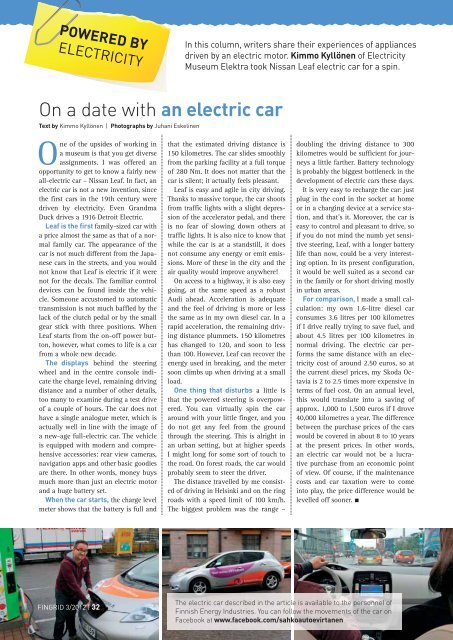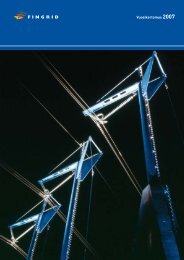3/2012 - Fingrid
3/2012 - Fingrid
3/2012 - Fingrid
Create successful ePaper yourself
Turn your PDF publications into a flip-book with our unique Google optimized e-Paper software.
POWERED BY<br />
ELECTRICITY<br />
In this column, writers share their experiences of appliances<br />
driven by an electric motor. Kimmo Kyllönen of Electricity<br />
Museum Elektra took Nissan Leaf electric car for a spin.<br />
On a date with an electric car<br />
Text by Kimmo Kyllönen | Photographs by Juhani Eskelinen<br />
One of the upsides of working in<br />
a museum is that you get diverse<br />
assignments. I was offered an<br />
opportunity to get to know a fairly new<br />
all-electric car – Nissan Leaf. In fact, an<br />
electric car is not a new invention, since<br />
the first cars in the 19th century were<br />
driven by electricity. Even Grandma<br />
Duck drives a 1916 Detroit Electric.<br />
Leaf is the first family-sized car with<br />
a price almost the same as that of a normal<br />
family car. The appearance of the<br />
car is not much different from the Japanese<br />
cars in the streets, and you would<br />
not know that Leaf is electric if it were<br />
not for the decals. The familiar control<br />
devices can be found inside the vehicle.<br />
Someone accustomed to automatic<br />
transmission is not much baffled by the<br />
lack of the clutch pedal or by the small<br />
gear stick with three positions. When<br />
Leaf starts from the on-off power button,<br />
however, what comes to life is a car<br />
from a whole new decade.<br />
The displays behind the steering<br />
wheel and in the centre console indicate<br />
the charge level, remaining driving<br />
distance and a number of other details,<br />
too many to examine during a test drive<br />
of a couple of hours. The car does not<br />
have a single analogue meter, which is<br />
actually well in line with the image of<br />
a new-age full-electric car. The vehicle<br />
is equipped with modern and comprehensive<br />
accessories: rear view cameras,<br />
navigation apps and other basic goodies<br />
are there. In other words, money buys<br />
much more than just an electric motor<br />
and a huge battery set.<br />
When the car starts, the charge level<br />
meter shows that the battery is full and<br />
that the estimated driving distance is<br />
150 kilometres. The car slides smoothly<br />
from the parking facility at a full torque<br />
of 280 Nm. It does not matter that the<br />
car is silent; it actually feels pleasant.<br />
Leaf is easy and agile in city driving.<br />
Thanks to massive torque, the car shoots<br />
from traffic lights with a slight depression<br />
of the accelerator pedal, and there<br />
is no fear of slowing down others at<br />
traffic lights. It is also nice to know that<br />
while the car is at a standstill, it does<br />
not consume any energy or emit emissions.<br />
More of these in the city and the<br />
air quality would improve anywhere!<br />
On access to a highway, it is also easy<br />
going, at the same speed as a robust<br />
Audi ahead. Acceleration is adequate<br />
and the feel of driving is more or less<br />
the same as in my own diesel car. In a<br />
rapid acceleration, the remaining driving<br />
distance plummets. 150 kilometres<br />
has changed to 120, and soon to less<br />
than 100. However, Leaf can recover the<br />
energy used in breaking, and the meter<br />
soon climbs up when driving at a small<br />
load.<br />
One thing that disturbs a little is<br />
that the powered steering is overpowered.<br />
You can virtually spin the car<br />
around with your little finger, and you<br />
do not get any feel from the ground<br />
through the steering. This is alright in<br />
an urban setting, but at higher speeds<br />
I might long for some sort of touch to<br />
the road. On forest roads, the car would<br />
probably seem to steer the driver.<br />
The distance travelled by me consisted<br />
of driving in Helsinki and on the ring<br />
roads with a speed limit of 100 km/h.<br />
The biggest problem was the range –<br />
doubling the driving distance to 300<br />
kilometres would be sufficient for journeys<br />
a little farther. Battery technology<br />
is probably the biggest bottleneck in the<br />
development of electric cars these days.<br />
It is very easy to recharge the car: just<br />
plug in the cord in the socket at home<br />
or in a charging device at a service station,<br />
and that’s it. Moreover, the car is<br />
easy to control and pleasant to drive, so<br />
if you do not mind the numb yet sensitive<br />
steering, Leaf, with a longer battery<br />
life than now, could be a very interesting<br />
option. In its present configuration,<br />
it would be well suited as a second car<br />
in the family or for short driving mostly<br />
in urban areas.<br />
For comparison, I made a small calculation:<br />
my own 1.6-litre diesel car<br />
consumes 3.6 litres per 100 kilometres<br />
if I drive really trying to save fuel, and<br />
about 4.5 litres per 100 kilometres in<br />
normal driving. The electric car performs<br />
the same distance with an electricity<br />
cost of around 2.50 euros, so at<br />
the current diesel prices, my Skoda Octavia<br />
is 2 to 2.5 times more expensive in<br />
terms of fuel cost. On an annual level,<br />
this would translate into a saving of<br />
approx. 1,000 to 1,500 euros if I drove<br />
40,000 kilometres a year. The difference<br />
between the purchase prices of the cars<br />
would be covered in about 8 to 10 years<br />
at the present prices. In other words,<br />
an electric car would not be a lucrative<br />
purchase from an economic point<br />
of view. Of course, if the maintenance<br />
costs and car taxation were to come<br />
into play, the price difference would be<br />
levelled off sooner. <br />
FINGRID 3/<strong>2012</strong> | 32<br />
The electric car described in the article is available to the personnel of<br />
Finnish Energy Industries. You can follow the movements of the car on<br />
Facebook at www.facebook.com/sahkoautoevirtanen

















